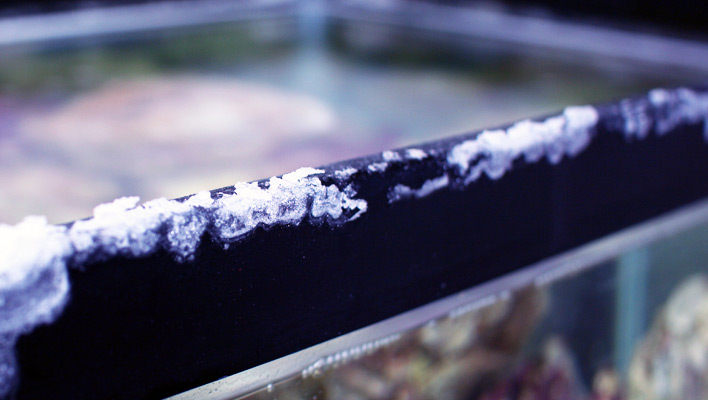For marine aquarium hobbyists, the only certain things in life are death, taxes, and salt creep. There’s very little we can do about the first two, but salt creep, while just as inevitable, can usually be kept to a manageable level.
If you’re new to the hobby and haven’t yet experienced or heard of salt creep, it isn’t the name of some diabolical super villain wreaking havoc in Gotham City. Rather, it’s the crusty buildup of salt that develops on any surface on or around the aquarium that’s exposed to saltwater spray or splashes—such as tank rims, covers, stands, power cords, protein skimmers, overflows, light fixtures, etc.
Remember, only pure fresh water evaporates, so when salt water splashes on these surfaces and dries up, all the stuff dissolved in it—i.e., the salt—gets left behind. Without regular cleaning, the resultant buildup will gradually increase in thickness and spread further over surfaces. Hence the name “salt creep.”
Now that you know what salt creep is, here are five techniques for controlling it:
#1 Minimize surface splashing
Vigorous water movement at the surface of your aquarium is desirable because it helps promote proper gas exchange, but you don’t want splashing if you can help it. For instance, if you use airstones or a bubble wand to create water movement, all those rising bubbles constantly bursting at the surface will lead to quite a buildup of salt creep. In contrast, positioning a submersible powerhead just below the surface will create a nice roiling effect with minimal splashing. Similarly, if your system includes a sump, position the nozzle of the return hose/pipe so it discharges below the waterline rather than above it.
#2 Put a lid on it
Putting a cover glass on your aquarium will significantly reduce salt creep on surfaces adjacent to or above the tank. Of course, the cover itself will still be vulnerable to buildup, but it’s a lot easier to clean just the cover glass rather than every surface around the tank.
I should point out, however, that this may not be the best option for reef systems, as a cover glass combined with high-intensity reef lighting can cause the water temperature to climb precipitously high. Also, salt and calcium carbonate buildup on the cover glass can reduce light penetration to the detriment of photosynthetic corals. The gas exchange between air and water could potentially be adversely affected (depending upon other factors in the system), as well.
#3 Clean your light fixture regularly
Salt creep and light fixtures are a bad combination for several reasons. One is that salt creep building up on the splash lens reduces the intensity of the light passing through. Another is that salt creep penetrating inside the fixture itself can clog and corrode components, leading to unsafe operation or failure of the unit. Regular cleaning is a must.
Here’s how:
- With the fixture disconnected from the power source, use a slightly damp cloth to wipe down the exterior.
- Remove the splash lens and either wipe it with a moist cloth or rinse it in tap water.
- Clean any salt creep buildup from the tracks that hold the splash lens. A small aquarium brush or old toothbrush will work well for this chore.
- Use a dry cloth to clean bulbs, tubes, pins, sockets, or any other component that gets energized.
- Dry any damp components completely before reassembling the fixture and plugging it back in.
#4 Remove valued objects from “The Salt Creep Zone”
Any valued furnishings, artwork, knick-knacks, gewgaws, doodads, or doohickeys subject to damage or corrosion from salt creep, should be moved a fair distance from the tank. Thingamabobs, on the other hand . . .
#5 Clean early and clean often!
Salt creep tends to build up very gradually, so the more frequently you wipe down affected surfaces, the easier the cleanup job and the better your aquarium and equipment will look. Once-weekly cleanings are usually sufficient to stay ahead of salt creep without having to use too much elbow grease.



